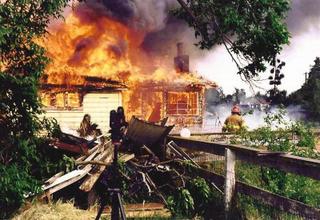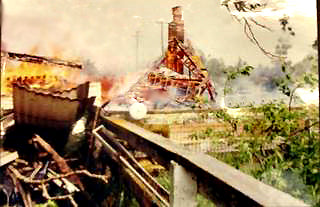Gun Safe Fire Testing Comparison
The Way Sturdy Safe Tests Fire Safes

The pictures shown here are of Sturdy Safes burn down test done with Sturdy's fire lined gun safes.
Oven tests were performed, however, the real test came when Sturdy Safe became acquainted with the Central Valley Arson Investigation School located in Fresno, CA.
From that origination and the fire department, we were able to burn fully furnished houses to the ground.
Sturdy Safe took this opportunity to see what fire insulating methods worked, by trying several different types of liners including, but not limited to: a layer of cement compound, fire board, and fire board with a layer of ceramic.
These fire liners had poor-terrible overall performance. From experience, we can say that sheet rock or anything like it just doesn't cut it.

This is a picture of Terry Pratt, (owner of Sturdy Safe) over 28 years ago when he started testing his fire liner materials and designs.
Arson investigators used methods to make the house burn quicker and as a result of that, it burned hotter than usual house fires sooner than normal and they let it burn all the way down opposed to trying to put the fire out like normal accidental burn downs.
Until the house was safe enough to retrieve the gun safe, we were not allowed to get it, which shows how important cool down time is when taking fire ratings into consideration.

This is all that remained of the house after the burn.
Sturdy performed this test with the intent to find out what could withstand a real fire test, as well as, to find out how various items inside the safe would be affected.
In conclusion, we now know what really works for fire insulators.
The Way Other Safe Companies Rate Fire Safe

Most safe companies test their safes in controlled testing furnaces, which perform like oversized house ovens, yet get a lot hotter than your normal oven.
These safe companies tell the laboratory to eliminate 2 important factors when testing their sheet rock lined safes: 1st. Point Of No Return - Most safe companies eliminate point of no return, as if it is not a factor (this means when the inside wall of the safe is hot enough to carry the inside temperature to combustion and there is nothing one can do to cool it down). 2nd. Cool Down Time - They eliminate cool down time (a time that every safe must go through before you can open it). Within this time of cooling, the safe is still cooking.
For example, if one took a frying pan off a stove, the heat is still going to cook the hamburger on the pan, even though the heat is off it.
A safe is a lot thicker and bigger than a frying pan, so just imagine the amount of time it really takes it to cool.
Eliminating those two factors will make cheap fire lined safes look like they do well in fire rating tests.
Why would our competitors do this?
Because it's the cheapest material that can be called an insulator.
More Information: A UL RSC Rating only has to deal with the security of the safe and not the fire rating. When safe companies actually list a UL Fire Rating, the majority are only referring to UL Fire Rating of the insulation itself. UL WILL NOT TEST A SAFE LINED WITH FIRE RATED SHEETROCK.
